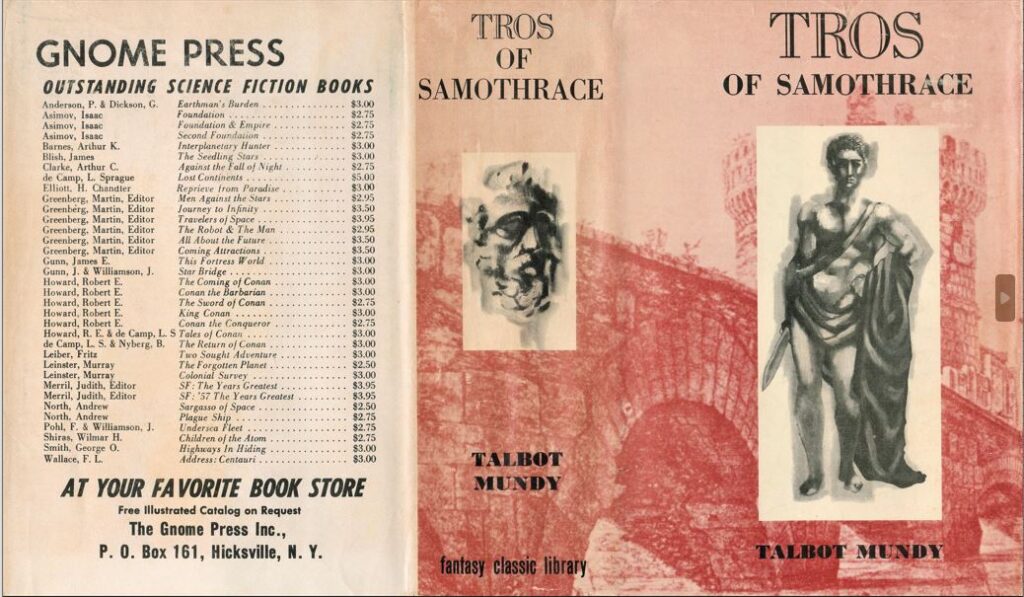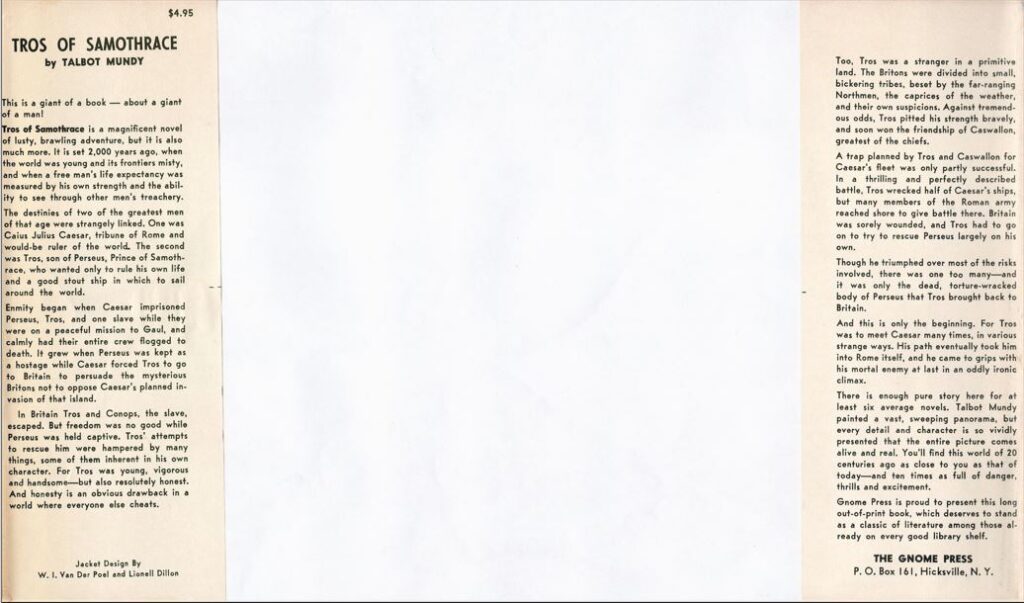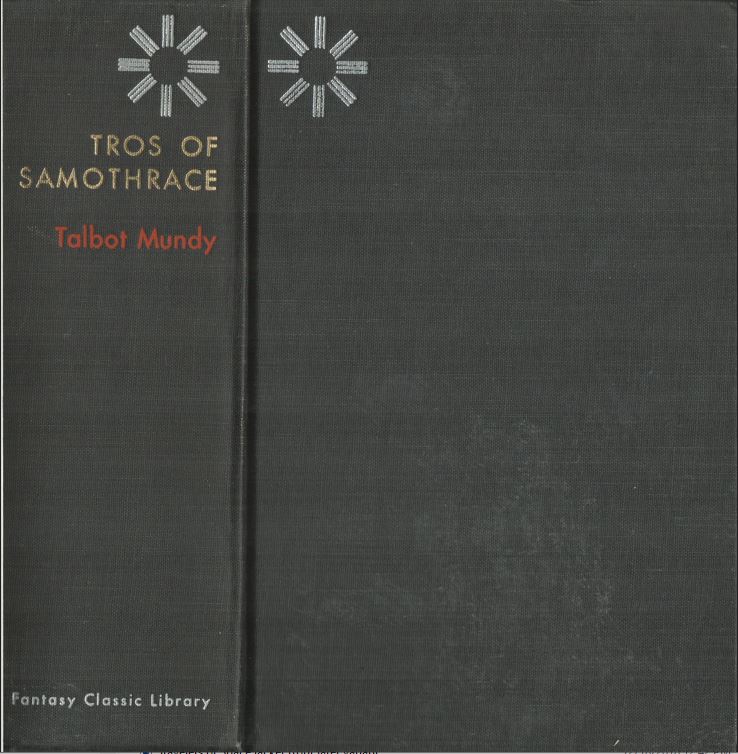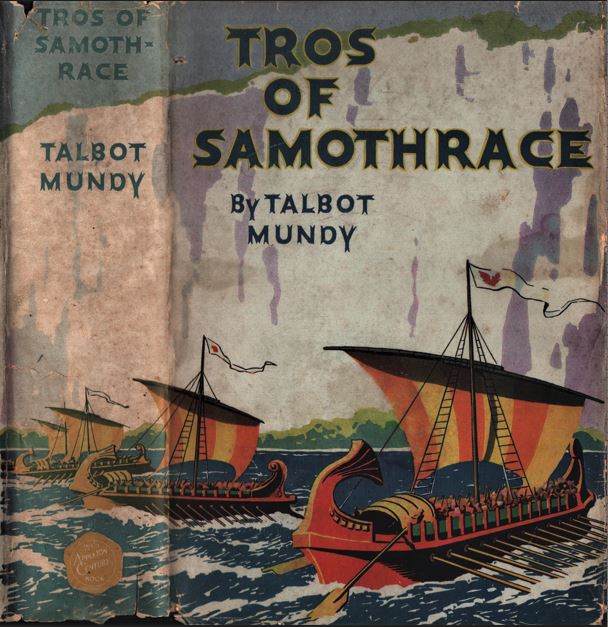Comments
“’Tros of Samothrace’ is a fantasy classic, and Talbot Mundy is usually listed as the father of modern science fiction, just as ‘The Murder in the Rue Morgue’ made Poe the father of mystery fiction.” This jaw-dropping statement appeared in the Elk Grove Herald on July 14, 1960, a suburban supplement to the Chicago Herald. Tros was one of nine Gnome books the Prospect Heights Public Library added that week. What William Lancaster Gribbon would have made of his progeny is unknowable, but let’s take the accolade as a compliment and quickly move on.
Gribbon (1879-1940) lived a life out of his books, leaving Rugby to run away with a circus, emigrating to India, tramp steaming to Australia, spending prison time on a road gang, and making a living as “a petty criminal, ivory poacher, and confidence trickster in Africa,” according to The Encyclopedia of Fantasy. America seemed preferable to prison and he appears there in 1909, quickly realizing that his past was his future. His first of millions of words for the pulp Adventure was the evocative “Pig-Sticking In India” in the April 1911 issue under the pseudonym of Talbot Mundy. He made that his legal name when he became an American citizen in 1916.
Tros’s exploits appeared as a series of progressively longer stories in Adventure from 1925 to 1926, but weren’t collected as a book until 1934. The story behind that is an adventure of its own and works as a perfect precursor to the f&sf small press story, one of swarms of fans who brought back lost stories from unfindable pulps to give them permanence between hardcovers.
Rose Wilder Lane conforms to few stereotypes about women born in the 19th century. Before the age of 20 she worked as a telegrapher in several states and only upped her traveling during and after an early and unhappy marriage. Along the way she discovered a gift for writing and languages, turning those skills into a long freelance career as a biographer, travel writer, and novelist. She also happened to be the daughter of Laura Ingalls Wilder and is critical to the publication – and maybe the writing – of the Little House series. Perversely, Laura Wilder is critical to this tale, as an archetypal mother. While Lane was traveling in Albania, Wilder threw out Lane’s beloved old copies of Adventure with the Tros stories in them. “I set out to get that story in book [sic],” she later wrote a friend, “which was the only way to get it in print. Talbot Mundy wrote it, and he didn’t want to tackle rewrite on a 1,500-page manuscript. Then publishers said the book was to [sic] long and they had other books by Talbot Mundy that they were interested in. But I kept after that story, till now at last, after seven years – and after I had got two other publishers hot after it – Appleton-Century are publishing it next month. And I have just read it in galley proof and like it more than ever.”
Gnome Notes
Tros went through eight printings until 1943, but hadn’t been available for over a decade when Greenberg had one of his biggest ideas.
His series of Howard’s Conan stories had been mostly a critical and popular success, with even Björn Nyberg’s fan tribute going over well in 1957. The science fiction pulps had been overmined by Gnome and the other small presses until virtually nothing was left. Fantasy suffered less from this relentless cherrypicking. Mundy represented a potentially untouched seam with huge advantages, the first of many still-famous older names (his King of the Kyber Rifles had been a Major Motion Picture in 1953) who could be flogged to a public tired of the familiar. That his books had but the faintest tinge of fantasy could be overlooked by those who thrilled to brawny, lusty heroes who made for obvious precursors of Conan. (Uncharitably, that Mundy was long dead and unable to stop in at the office demanding royalties made for an additional lure.)
Greenberg released Tros as the first book in a proposed new imprint, the Fantasy Classic Library. The words appear on the spines of both the boards and the dust jacket, although the Gnome Press connection was manifest from the back panel of Gnome titles to the firm name on the title and copyright pages. The ads for the book made sure potential buyers put two and two together as well, asking them to send their money to The Gnome Press Inc.
A long series of ads in Galaxy and If, as well as Astounding even after the name change to Analog, followed. That kind of expense, unheard of for years by Gnome, reveals the huge expectations Greenberg had for this venture. Odd then that CHALKER said “5000 printed but only a small fraction (perhaps no more than 2000) of that bound.” Even odder since Chalker knew that a later second binding of green boards existed. The evidence suggests that most copies were bound and sold well, with many listings online today. Mundy and Heinlein were the only two books in a string from 1957 to 1959 that ESHBACH didn’t report being remaindered.
Mysterious as well is CHALKER’s assertion that “Price raised to $5.95 with second binding.” My copy of the green boards came without a dust jacket, and all copies for sale online also lack one, so I can’t confirm that. What I can say for certain is that the price listed for Tros on the back panel of The Philosophical Corps is $6.00. Nothing on that bizarre cover is necessarily reliable, but the price is backed up by the 1963 Gnome catalog. Yet as late as the November 1961 Analog, Tros was still priced at $4.95.
We are left with a stack of unknowns. When were the green boards released? Take that back. Start with, when were the first state black boards released? As a reprint of a copyrighted book, no copyright registration was required. It also lacks a Library of Congress catalog number for no apparent reason. Surrounding books aren’t much help. The next book, Starman’s Quest, also failed to be registered, putting it instantly in the public domain. Nothing is more obvious that Greenberg didn’t have an assistant to do paperwork in those late days. The LoC retroactively bestowed books with catalog numbers and the number given to Tros – 58-8768 – places it in the group along with 58-8766, Path of Unreason, and 58-8767, Starman’s Quest, yet Path has a copyright date of July 25, 1959, and is definitely a 1959 title.
The first newspaper mention is equally bizarre. The Santa Rose [CA] Press-Democrat on October 29, 1958, printed a letter to the editor consisted of little but “the sayings of Druid Taliesan” from the Gnome edition of Tros. I’ve read thousands of old newspapers and never seen anything to compare.
Everybody puts Tros into 1958 and I have to agree, though it undoubtedly missed what the early Astounding ad predicted as its scheduled printing of January 1958: the first library mention is not until January 16, 1959. (Mentions of libraries adding the Gnome edition last until 1963.)
Sadly, the green boards fail to reach even that mild level of quasi-certainty. KEMP gives 1960 for the second binding, which seems solid. As I’ve noted repeatedly one can usually tell when a second binding appears by the title’s disappearing and reappearing off the back panels. No such luck with Tros. It appears first in 1959 alongside Purple and then the two are referenced until the end. The only deviation is the price raise to $6.00 on Philosophical, which I date to 1962. Tros is still $4.95 on 1961’s Gray Lensman, so the last book’s date doesn’t matter. That allows a second binding being released any year from 1959 to 1962. 1960 or 1961 are more likely, but the probabilities are indecently scattered.
Wrappers are as Schrodinger-like as the dates of release. Two possibilities exist for the green boards dust jacket. One is that the $5.95 or $6.00 price is a phantom or that two states were released, one with the $4.95 price and one with a higher price, neither of which can be confirmed.
Continuing the inglorious Gnome tradition of typoing names, Lionel Dillon’s name was misspelled as “Lionell” on the front flap.
Reviews
Unsigned, Kirkus Reviews, June 15, 1934
This is the type of book that is one of the tragedies of the book business, — a stupendous piece of work, scholarly research, careful craftsmanship, presentation of a little known subject and period, and the result a volume that few people will find interesting, and that scholars will belittle because of its fiction form. … The entire 900 pages are filled with deceit, treachery, killing, torture; a maze of battles and plots and counterplots, gladiatorial combats, tormenting of animals, slaves and prisoners; blood thirsty crowds of cheering men and women. … Possibly men who find ancient history absorbing and who revel in military tactics and strategy will enjoy it. Very few women will read it. The appeal is definitely limited.
P. Schuyler Miller, Astounding Science Fiction, March 1959
Tros is the heroic counterpart of Conan, Prince Valiant, and many another swashbuckler, but thanks to the author’s skill a far more real personality.
Contents and Original Publications
• Chapters 1-14 (Adventure, February 10, 1925 as “Tros of Samothrace”).
• Chapters 15-26 (Adventure, April 10, 1925 as “The Enemy of Rome”).
• Chapters 27-37 (Adventure, June 10, 1925 as “Prisoners of War”).
• Chapters 38-51 (Adventure, August 20, 1925 as “Hostages to Luck”).
• Chapters 52-66 (Adventure, October 10, 1925 as “Admiral of Caesar’s Fleet”).
• Chapters 67-81 (“The Dancing Girl of Gades,” Adventure, December 10, 1925 as “The Dancing Girl of Gades”).
• Chapters 82-87 (Adventure, February 10, 1926 as “Messenger of Destiny, part 1”).
• Chapters 88-92 (Adventure, February 20, 1926 as “Messenger of Destiny, part 2”).
• Chapters 93-96. (Adventure, February 28, 1926 as “Messenger of Destiny, part 3”).
Bibliographic Information
Tros of Samothrace, by Talbot Mundy, 1958, [no copyright registration], Library of Congress Catalog Card Number not given [retroactively 58-8768], title #72, back panel #38, 949 pages, $4.95. 5000 copies printed. Hardback, Fantasy Classic Library on spine replacing Gnome. Jacket design by W. I. Van der Poel and Lionell [typo of Lionel] Dillon. “GNOME PRESS EDITION 1958” on copyright page. Printed in the United States of America. Back panel: 35 titles. Gnome Press address given as P. O. Box 161, Hicksville, N.Y.
Variants, in probable order of priority
1) Black cloth, spine lettered in silver and red, $4.95.
2) Green boards, spine lettered in black, $4.95. [dust jacket not seen].
3) Green boards, spine lettered in black, possibly priced $5.95 or $6.00 [not seen or verified].
True first edition
New York: D. Appleton-Century Co., 1934.
Images









